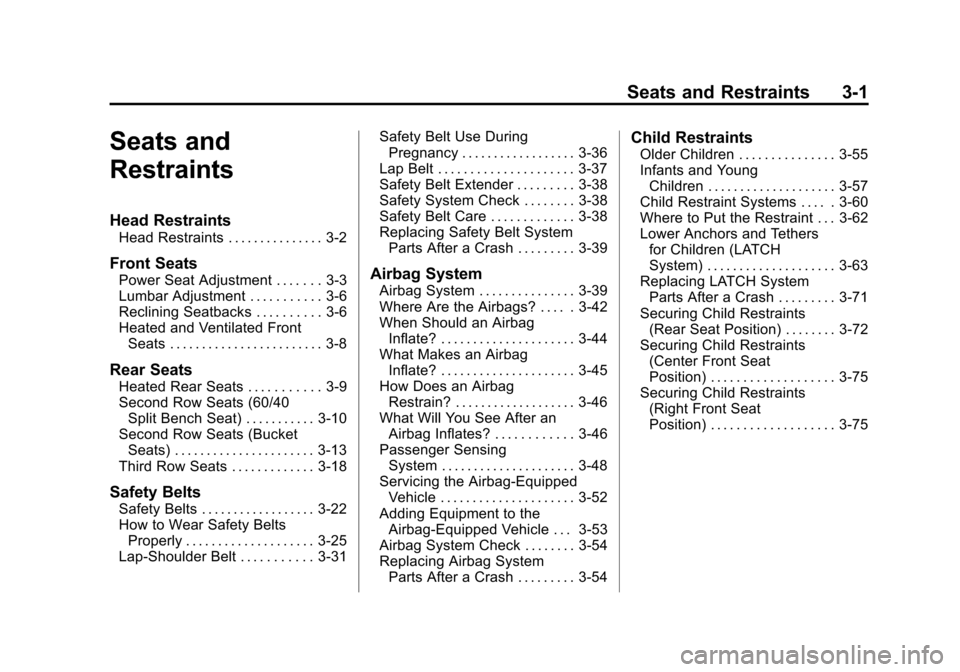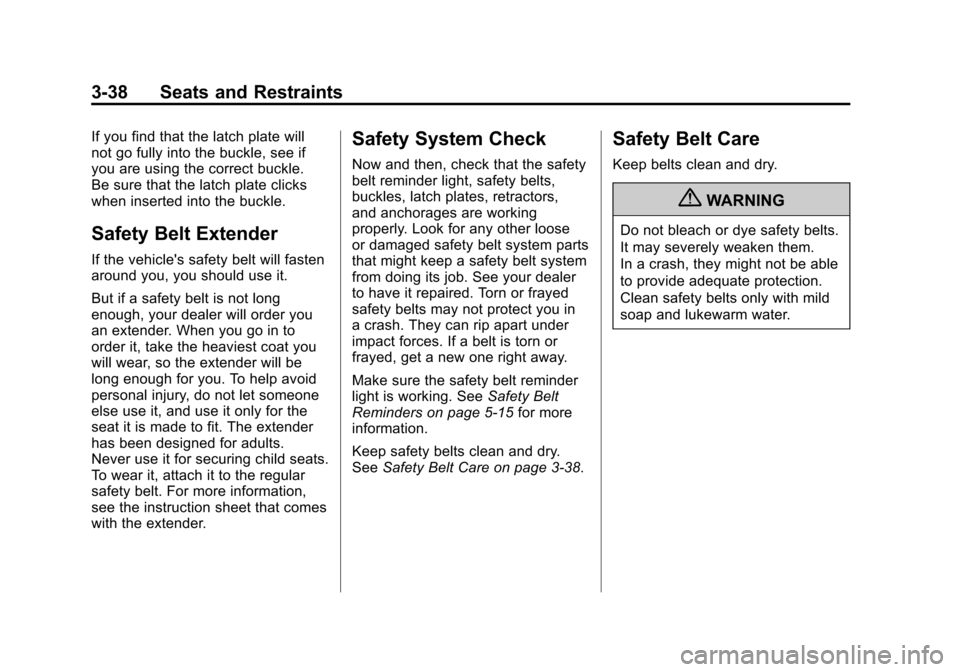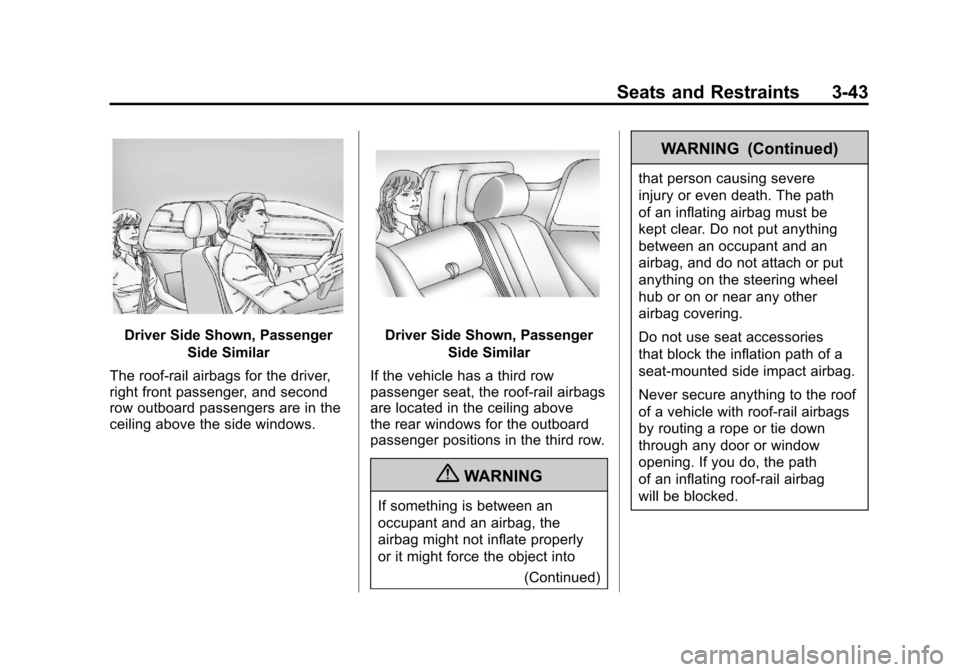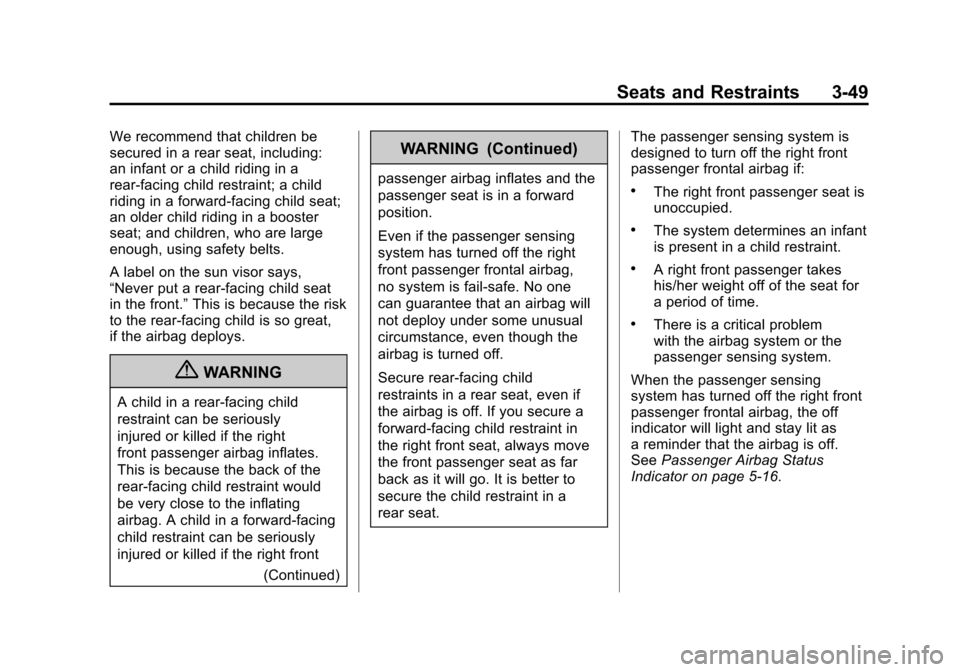2011 CADILLAC ESCALADE ECU
[x] Cancel search: ECUPage 48 of 558

Black plate (16,1)Cadillac Escalade/Escalade ESV Owner Manual - 2011
2-16 Keys, Doors and Windows
4. Insert the new key to beprogrammed and turn it to
the ON/RUN position within
five seconds of turning the
ignition to the LOCK/OFF
position in Step 3.
The security light will turn
off once the key has been
programmed.
5. Repeat Steps 1 through 4 if additional keys are to be
programmed.
If you lose or damage your
PASS-Key III+ key, see your dealer
or a locksmith who can service
PASS-Key III+ to have a new
key made.
Do not leave the key or device
that disarms or deactivates the
theft-deterrent system in the vehicle.Exterior Mirrors
Convex Mirrors
{WARNING
A convex mirror can make things,
like other vehicles, look farther
away than they really are. If you
cut too sharply into the right lane,
you could hit a vehicle on the
right. Check the inside mirror or
glance over your shoulder before
changing lanes.
The passenger side mirror is convex
shaped. A convex mirror's surface is
curved so more can be seen from
the driver seat.
Power Mirrors
Controls for the outside power
foldaway mirrors are on the driver
door armrest.
Page 57 of 558

Black plate (1,1)Cadillac Escalade/Escalade ESV Owner Manual - 2011
Seats and Restraints 3-1
Seats and
Restraints
Head Restraints
Head Restraints . . . . . . . . . . . . . . . 3-2
Front Seats
Power Seat Adjustment . . . . . . . 3-3
Lumbar Adjustment . . . . . . . . . . . 3-6
Reclining Seatbacks . . . . . . . . . . 3-6
Heated and Ventilated FrontSeats . . . . . . . . . . . . . . . . . . . . . . . . 3-8
Rear Seats
Heated Rear Seats . . . . . . . . . . . 3-9
Second Row Seats (60/40Split Bench Seat) . . . . . . . . . . . 3-10
Second Row Seats (Bucket Seats) . . . . . . . . . . . . . . . . . . . . . . 3-13
Third Row Seats . . . . . . . . . . . . . 3-18
Safety Belts
Safety Belts . . . . . . . . . . . . . . . . . . 3-22
How to Wear Safety Belts Properly . . . . . . . . . . . . . . . . . . . . 3-25
Lap-Shoulder Belt . . . . . . . . . . . 3-31 Safety Belt Use During
Pregnancy . . . . . . . . . . . . . . . . . . 3-36
Lap Belt . . . . . . . . . . . . . . . . . . . . . 3-37
Safety Belt Extender . . . . . . . . . 3-38
Safety System Check . . . . . . . . 3-38
Safety Belt Care . . . . . . . . . . . . . 3-38
Replacing Safety Belt System Parts After a Crash . . . . . . . . . 3-39
Airbag System
Airbag System . . . . . . . . . . . . . . . 3-39
Where Are the Airbags? . . . . . 3-42
When Should an AirbagInflate? . . . . . . . . . . . . . . . . . . . . . 3-44
What Makes an Airbag Inflate? . . . . . . . . . . . . . . . . . . . . . 3-45
How Does an Airbag
Restrain? . . . . . . . . . . . . . . . . . . . 3-46
What Will You See After an Airbag Inflates? . . . . . . . . . . . . 3-46
Passenger Sensing System . . . . . . . . . . . . . . . . . . . . . 3-48
Servicing the Airbag-Equipped Vehicle . . . . . . . . . . . . . . . . . . . . . 3-52
Adding Equipment to the Airbag-Equipped Vehicle . . . 3-53
Airbag System Check . . . . . . . . 3-54
Replacing Airbag System Parts After a Crash . . . . . . . . . 3-54
Child Restraints
Older Children . . . . . . . . . . . . . . . 3-55
Infants and YoungChildren . . . . . . . . . . . . . . . . . . . . 3-57
Child Restraint Systems . . . . . 3-60
Where to Put the Restraint . . . 3-62
Lower Anchors and Tethers for Children (LATCH
System) . . . . . . . . . . . . . . . . . . . . 3-63
Replacing LATCH System Parts After a Crash . . . . . . . . . 3-71
Securing Child Restraints (Rear Seat Position) . . . . . . . . 3-72
Securing Child Restraints (Center Front Seat
Position) . . . . . . . . . . . . . . . . . . . 3-75
Securing Child Restraints (Right Front Seat
Position) . . . . . . . . . . . . . . . . . . . 3-75
Page 88 of 558

Black plate (32,1)Cadillac Escalade/Escalade ESV Owner Manual - 2011
3-32 Seats and Restraints
2. Pick up the latch plate and pullthe belt across you. Do not let it
get twisted.
The lap-shoulder belt may lock if
you pull the belt across you very
quickly. If this happens, let the
belt go back slightly to unlock it.
Then pull the belt across you
more slowly.
If the shoulder portion of a
passenger belt with a free‐falling
latch plate is pulled out all the
way, the child restraint locking
feature may be engaged. If this
happens, let the belt go back all
the way and start again.
Engaging the child restraint
locking feature in the right front
seating position may affect the
passenger sensing system,
if equipped. See Passenger
Sensing System on page 3‑48
for more information.
If the belt stops before it reaches
the buckle, for lap‐shoulder belts
with cinching latch plates, tilt
the latch plate and keep pulling
the safety belt until it can be
buckled.3. Push the latch plate into the buckle until it clicks. If you find
that the latch plate will not go
fully into the buckle, see if you
are using the correct buckle.
Pull up on the latch plate to
make sure it is secure. If the belt
is not long enough, see Safety
Belt Extender on page 3‑38.
Position the release button on
the buckle so that the safety belt
could be quickly unbuckled if
necessary.
Page 94 of 558

Black plate (38,1)Cadillac Escalade/Escalade ESV Owner Manual - 2011
3-38 Seats and Restraints
If you find that the latch plate will
not go fully into the buckle, see if
you are using the correct buckle.
Be sure that the latch plate clicks
when inserted into the buckle.
Safety Belt Extender
If the vehicle's safety belt will fasten
around you, you should use it.
But if a safety belt is not long
enough, your dealer will order you
an extender. When you go in to
order it, take the heaviest coat you
will wear, so the extender will be
long enough for you. To help avoid
personal injury, do not let someone
else use it, and use it only for the
seat it is made to fit. The extender
has been designed for adults.
Never use it for securing child seats.
To wear it, attach it to the regular
safety belt. For more information,
see the instruction sheet that comes
with the extender.
Safety System Check
Now and then, check that the safety
belt reminder light, safety belts,
buckles, latch plates, retractors,
and anchorages are working
properly. Look for any other loose
or damaged safety belt system parts
that might keep a safety belt system
from doing its job. See your dealer
to have it repaired. Torn or frayed
safety belts may not protect you in
a crash. They can rip apart under
impact forces. If a belt is torn or
frayed, get a new one right away.
Make sure the safety belt reminder
light is working. SeeSafety Belt
Reminders on page 5‑15 for more
information.
Keep safety belts clean and dry.
See Safety Belt Care on page 3‑38.
Safety Belt Care
Keep belts clean and dry.
{WARNING
Do not bleach or dye safety belts.
It may severely weaken them.
In a crash, they might not be able
to provide adequate protection.
Clean safety belts only with mild
soap and lukewarm water.
Page 97 of 558

Black plate (41,1)Cadillac Escalade/Escalade ESV Owner Manual - 2011
Seats and Restraints 3-41
{WARNING
Airbags inflate with great force,
faster than the blink of an eye.
Anyone who is up against, or
very close to, any airbag when it
inflates can be seriously injured
or killed. Do not sit unnecessarily
close to the airbag, as you would
be if you were sitting on the edge
of your seat or leaning forward.
Safety belts help keep you in
position before and during a
crash. Always wear your safety
belt, even with airbags. The driver
should sit as far back as possible
while still maintaining control of
the vehicle.
Occupants should not lean on or
sleep against the door or side
windows in seating positions with
seat-mounted side impact airbags
and/or roof-rail airbags.
{WARNING
Children who are up against,
or very close to, any airbag
when it inflates can be seriously
injured or killed. Airbags plus
lap-shoulder belts offer protection
for adults and older children,
but not for young children and
infants. Neither the vehicle's
safety belt system nor its airbag
system is designed for them.
Young children and infants
need the protection that a child
restraint system can provide.
Always secure children properly
in your vehicle. To read how, see
Older Children on page 3‑55or
Infants and Young Children on
page 3‑57.
There is an airbag readiness light
on the instrument panel cluster,
which shows the airbag symbol.
The system checks the airbag
electrical system for malfunctions.
The light tells you if there is an
electrical problem. See Airbag
Readiness Light on page 5‑16
for more information.
Page 99 of 558

Black plate (43,1)Cadillac Escalade/Escalade ESV Owner Manual - 2011
Seats and Restraints 3-43
Driver Side Shown, PassengerSide Similar
The roof-rail airbags for the driver,
right front passenger, and second
row outboard passengers are in the
ceiling above the side windows.Driver Side Shown, Passenger Side Similar
If the vehicle has a third row
passenger seat, the roof-rail airbags
are located in the ceiling above
the rear windows for the outboard
passenger positions in the third row.
{WARNING
If something is between an
occupant and an airbag, the
airbag might not inflate properly
or it might force the object into (Continued)
WARNING (Continued)
that person causing severe
injury or even death. The path
of an inflating airbag must be
kept clear. Do not put anything
between an occupant and an
airbag, and do not attach or put
anything on the steering wheel
hub or on or near any other
airbag covering.
Do not use seat accessories
that block the inflation path of a
seat-mounted side impact airbag.
Never secure anything to the roof
of a vehicle with roof-rail airbags
by routing a rope or tie down
through any door or window
opening. If you do, the path
of an inflating roof-rail airbag
will be blocked.
Page 104 of 558

Black plate (48,1)Cadillac Escalade/Escalade ESV Owner Manual - 2011
3-48 Seats and Restraints
.Let only qualified technicians
work on the airbag systems.
Improper service can mean that
an airbag system will not work
properly. See your dealer for
service.
Passenger Sensing
System
If the vehicle has the passenger
airbag status indicator pictured in
the following illustration, then the
vehicle has a passenger sensing
system for the right front passenger
position. The passenger airbag
status indicator, if equipped, is
visible on the overhead console
when the vehicle is started.
In addition, if the vehicle has a
passenger sensing system for the
right front passenger position, the
label on the vehicle's sun visors
refers to“ADVANCED AIRBAGS”.
United States
Canada and Mexico
The words ON and OFF, or the
symbols for on and off, will be
visible during the system check.
If you are using remote start,
if equipped, to start the vehicle
from a distance, you may not see
the system check. When the system
check is complete, either the word
ON or OFF, or the symbol for on or
off, will be visible. See Passenger
Airbag Status Indicator on
page 5‑16. The passenger sensing system will
turn off the right front passenger
frontal airbag under certain
conditions. The driver airbag,
seat‐mounted side impact airbags
(if equipped) and the roof-rail
airbags are not affected by the
passenger sensing system.
The passenger sensing system
works with sensors that are part
of the right front passenger seat
and safety belt. The sensors are
designed to detect the presence
of a properly-seated occupant
and determine if the right front
passenger frontal airbag should
be enabled (may inflate) or not.
According to accident statistics,
children are safer when properly
secured in a rear seat in the correct
child restraint for their weight
and size.
Page 105 of 558

Black plate (49,1)Cadillac Escalade/Escalade ESV Owner Manual - 2011
Seats and Restraints 3-49
We recommend that children be
secured in a rear seat, including:
an infant or a child riding in a
rear-facing child restraint; a child
riding in a forward-facing child seat;
an older child riding in a booster
seat; and children, who are large
enough, using safety belts.
A label on the sun visor says,
“Never put a rear-facing child seat
in the front.”This is because the risk
to the rear-facing child is so great,
if the airbag deploys.
{WARNING
A child in a rear-facing child
restraint can be seriously
injured or killed if the right
front passenger airbag inflates.
This is because the back of the
rear-facing child restraint would
be very close to the inflating
airbag. A child in a forward-facing
child restraint can be seriously
injured or killed if the right front
(Continued)
WARNING (Continued)
passenger airbag inflates and the
passenger seat is in a forward
position.
Even if the passenger sensing
system has turned off the right
front passenger frontal airbag,
no system is fail-safe. No one
can guarantee that an airbag will
not deploy under some unusual
circumstance, even though the
airbag is turned off.
Secure rear-facing child
restraints in a rear seat, even if
the airbag is off. If you secure a
forward-facing child restraint in
the right front seat, always move
the front passenger seat as far
back as it will go. It is better to
secure the child restraint in a
rear seat. The passenger sensing system is
designed to turn off the right front
passenger frontal airbag if:.The right front passenger seat is
unoccupied.
.The system determines an infant
is present in a child restraint.
.A right front passenger takes
his/her weight off of the seat for
a period of time.
.There is a critical problem
with the airbag system or the
passenger sensing system.
When the passenger sensing
system has turned off the right front
passenger frontal airbag, the off
indicator will light and stay lit as
a reminder that the airbag is off.
See Passenger Airbag Status
Indicator on page 5‑16.